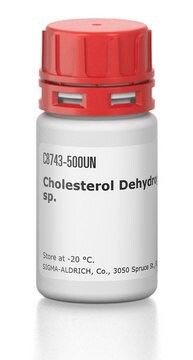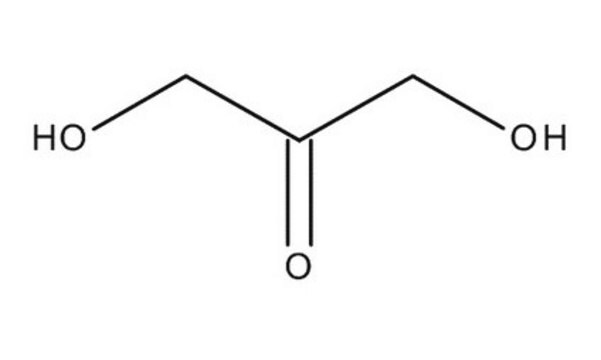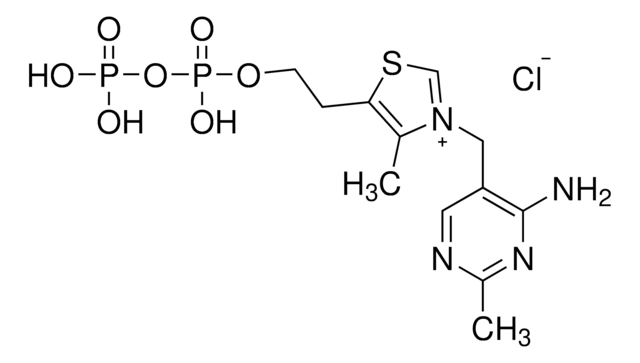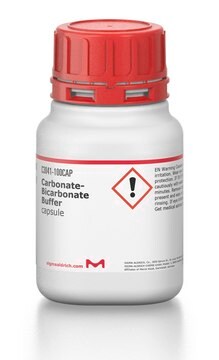G3512
Glycerol Dehydrogenase from Cellulomonas sp.
lyophilized powder, ≥50 units/mg protein
Sinónimos:
Glycerol:NAD+ 2-oxidoreductase
Iniciar sesiónpara Ver la Fijación de precios por contrato y de la organización
About This Item
EC Number:
MDL number:
UNSPSC Code:
12352204
NACRES:
NA.54
Productos recomendados
biological source
bacterial (Cellulomonas spp.)
Quality Level
form
lyophilized powder
specific activity
≥50 units/mg protein
mol wt
~390 kDa
composition
Protein, ≥60% biuret
storage temp.
−20°C
General description
Glycerol Dehydrogenase belongs to iron-containing alcohol dehydrogenase family. It is made up of eight identical subunits which are about 42,000 Da each. The C-terminal has histidine and the N-terminal has serine amino acid.
Application
Glycerol Dehydrogenase (GDH) from Cellulomonas sp. has been used in the determination of glycerol by sequential injection analysis (SIA) method. It has also been used in the preparation of pyrroloquinoline quinone (PQQ) based biosensor for the determination of glycerol.
This enzyme is useful for enzymatic determination of glycerol and of triglyceride when coupled with lipoprotein lipase in clinical analysis. Formation of NADH from the reaction of glycerol and NAD+ was catalyzed by the enzyme glycerol dehydrogenase.
Biochem/physiol Actions
Glycerol dehydrogenase catalyzes the conversion of glycerol to glycerone.
Physical properties
Isoelectric point : 4.4 ± 0.1
Michaelis constants : 1.1 x 10¯2M (Glycerol), 8.9 x 10¯5M (NAD+)
Structure : 10 subunits (42,000) per mol of enzyme
Inhibitors : p-Chloromercuribenzoate, o-phenanthroline, monoiodoacetate, heavy metal
ions (Co++, Ni++, Cu++, Zn++, Cd++)
Optimum pH : 10.0 – 10.5
Optimum temperature : 50°C
pH Stability : pH 7.5 – 10.5 (25°C, 20hr)
Thermal stability : below 55°C (pH 7.5, 15min)
Substrate specificity : This enzyme has the highest specificity for glycerol and 1,2-propanediol, and also oxidizes glycerol-α-monochlorohydrin, ethylene
glycol and 2,3-butanediol. The oxidative reaction is stimulated by K+, NH+4 and Rb+.
Michaelis constants : 1.1 x 10¯2M (Glycerol), 8.9 x 10¯5M (NAD+)
Structure : 10 subunits (42,000) per mol of enzyme
Inhibitors : p-Chloromercuribenzoate, o-phenanthroline, monoiodoacetate, heavy metal
ions (Co++, Ni++, Cu++, Zn++, Cd++)
Optimum pH : 10.0 – 10.5
Optimum temperature : 50°C
pH Stability : pH 7.5 – 10.5 (25°C, 20hr)
Thermal stability : below 55°C (pH 7.5, 15min)
Substrate specificity : This enzyme has the highest specificity for glycerol and 1,2-propanediol, and also oxidizes glycerol-α-monochlorohydrin, ethylene
glycol and 2,3-butanediol. The oxidative reaction is stimulated by K+, NH+4 and Rb+.
Unit Definition
One unit will oxidize 1.0 μmole of glycerol to dihydroxyacetone per min at 25 °C at pH 10.0.
Physical form
Lyophilized powder containing bovine serum albumin
signalword
Danger
hcodes
pcodes
Hazard Classifications
Resp. Sens. 1
Storage Class
11 - Combustible Solids
wgk_germany
WGK 3
flash_point_f
Not applicable
flash_point_c
Not applicable
ppe
Eyeshields, Gloves, type N95 (US)
Elija entre una de las versiones más recientes:
¿Ya tiene este producto?
Encuentre la documentación para los productos que ha comprado recientemente en la Biblioteca de documentos.
Los clientes también vieron
A glycerol dehydrogenase from Escherichia coli
R.E. Asnis & A.F. Brodie
The Journal of Biological Chemistry, 23, 153-159 (1953)
Simultaneous detection of ethanol, glucose and glycerol in wines using pyrroloquinoline quinone-dependent dehydrogenases based biosensors
Niculescu M, et al.
Food Chemistry, 82(3), 481-489 (2003)
Further characterization of glycerol dehydrogenase from Cellulomonas sp. NT3060
Nishise H, et al.
Agricultural and Biological Chemistry, 48(6), 1603-1609 (1984)
Sequential injection kinetic flow assay for monitoring glycerol in a sugar fermentation process by Saccharomyces cerevisiae
Dominguez KBH, et al.
Applied Biochemistry and Biotechnology, 160(6), 1664-1673 (2010)
An improved glycerol biosensor with an Au-FeS-NAD-glycerol-dehydrogenase anode
Mahadevan A and Fernando S
Biosensors And Bioelectronics, 92, 417-424 (2017)
Nuestro equipo de científicos tiene experiencia en todas las áreas de investigación: Ciencias de la vida, Ciencia de los materiales, Síntesis química, Cromatografía, Analítica y muchas otras.
Póngase en contacto con el Servicio técnico












